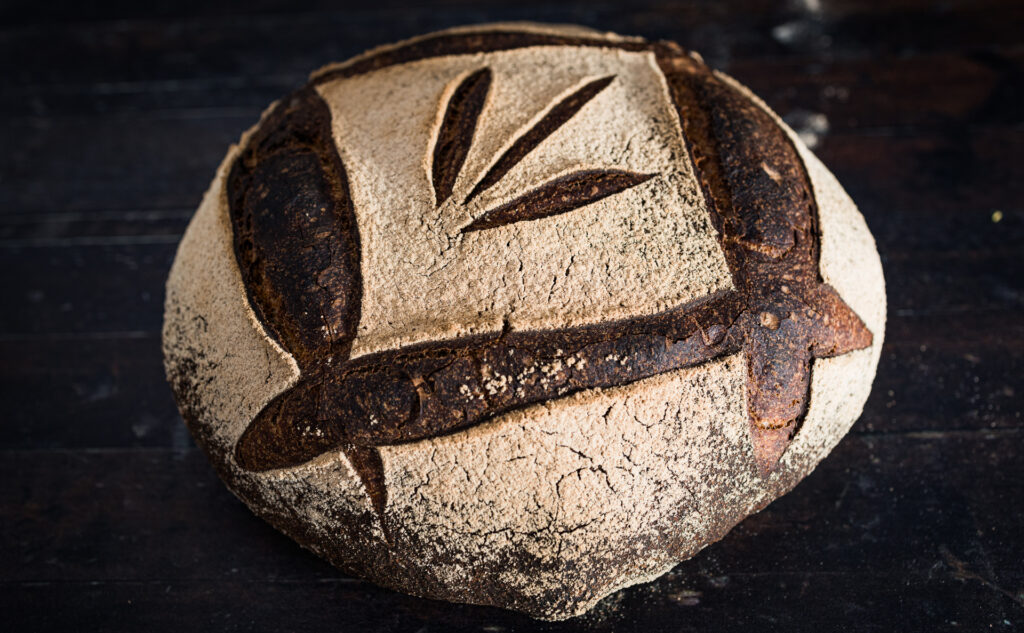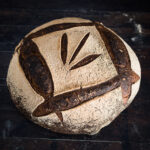French Classics
Rustic Tourte de Meule

A true taste of the French countryside. The Tourte de Meule is a traditional sourdough loaf made with stone-ground flour, prized for its thick, chewy crust, moist open crumb, and wonderfully complex flavor. This recipe guides you through creating this masterpiece at home.
The History of the Tourte de Meule
The name “Tourte de Meule” already reveals the heart of this bread. It literally translates to “millstone loaf.” This name is a tribute to the traditional method used to produce the flour for this bread: it is slowly ground between two heavy millstones.
In contrast to modern, industrially produced flour, stone-ground flour (often classified as T80 in France) retains a larger portion of the grain, including the bran and the germ. The result is a flour that is richer in nutrients, minerals, and, above all, flavor. It gives the bread its characteristic cream-colored crumb and a deep, nutty taste rarely found in mass-produced products.
The Tourte de Meule is a classic “Pain de Campagne” (country bread) and a symbol of France’s honest, rural baking tradition. Each loaf is a piece of history—a simple yet perfect bread made from just four ingredients: flour, water, salt, and time.

Tourte de Meule
Description
A true Tourte de Meule is a sensory experience, defined by the rustic character that comes from its traditional ingredients and long fermentation.
Crust
The crust is arguably one of its most defining features. It is typically:
- Thick and Hearty: Baked at a high initial temperature, the bread develops a substantial, deeply caramelized crust.
- Deeply Browned: The color ranges from a dark golden brown to a deep, rustic brown, which contributes significantly to the overall flavor.
- Chewy and Crisp: When fresh, the crust has a satisfying crispness that gives way to a pleasant chewiness. It’s not delicate or flaky, but robust and substantial. The crackling sound it makes when cooling is a classic sign of a good bake.
Crumb
The inside of the loaf offers a beautiful contrast to the rugged exterior:
- Soft and Moist: Despite the thick crust, the crumb is known for being wonderfully soft, moist, and tender. This is often achieved by a high hydration level in the dough.
- Open and Irregular: A well-made Tourte de Meule will have a moderately open crumb with irregular hole sizes—a hallmark of wild yeast fermentation. It’s not overly airy like a ciabatta, but it shouldn’t be dense.
- Creamy, Amber Color: Because it’s made with stone-ground T80 flour, which contains more of the wheat bran and germ, the crumb has a beautiful, creamy off-white or light amber color, flecked with darker bits of bran.
Taste
The flavor is where the Tourte de Meule truly shines. It is complex and layered:
- Earthy and Nutty: The primary flavor comes from the stone-ground flour, lending it a rich, earthy, and distinctly nutty or wheaty taste that is much more pronounced than in breads made with standard white flour.
- Slight Sourdough Tang: As a naturally leavened bread, it has a pleasant, mild sourness from the sourdough starter. This tang is not overpowering but beautifully balances the richness of the flour, adding complexity.
- Caramelized and Roasted Notes: The dark, thick crust imparts deep, roasted, and caramelized flavors that permeate the entire loaf, making every bite a rich and satisfying experience.
In summary, the Tourte de Meule is a bread of wonderful contrasts: a rugged, flavorful crust protecting a soft, moist, and tender crumb, all delivering a complex taste that is both rustic and deeply satisfying.
Ingredients
- 660 g T110 flour (alternative: German Type 1050 wheat flour)
- 500 g water (cold)
- 300 g wheat sourdough starter (levain)
- 17 g salt
- 30 g water (for bassinage)
Instructions
- Mix all ingredients except for the salt and the bassinage water, then cover and let rest at room temperature for 1 hour.
- Knead the dough at medium speed until it begins to develop elasticity. Now add the salt and continue kneading until the gluten structure is fully developed. If you are using a high-quality flour, you can now knead in up to 30g of additional water. Cover the dough and let it rise at room temperature for 3 hours. Perform a set of stretch and folds after the first hour and again after the second hour.
- Turn the dough out onto an un-floured work surface and shape it into a tight ball. Place it seam-side up into a floured proofing basket (banneton). Cover with a cloth and let it proof in the refrigerator for 12 hours
- Carefully turn the dough out onto a piece of parchment paper. Lightly dust the surface with flour and then score a diamond pattern with 4 vertical cuts. In a preheated oven at 250°C (top/bottom heat), pre-bake with plenty of steam for 10 minutes. Reduce the temperature to 220°C and bake for approximately 55-60 minutes until the crust is a deep, dark brown.